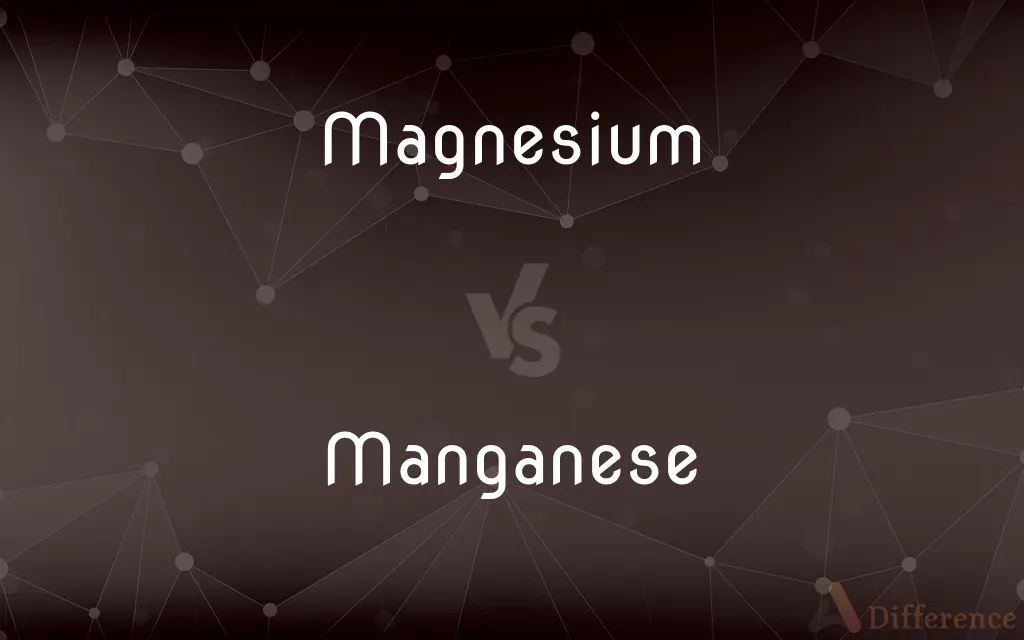Magnesium vs. Manganese — What's the Difference?
By Urooj Arif & Fiza Rafique — Updated on March 25, 2024
Magnesium is a crucial mineral for human health, involved in over 300 biochemical reactions, while manganese is a trace mineral essential for bone health and metabolic functions.

Difference Between Magnesium and Manganese
Table of Contents
ADVERTISEMENT
Key Differences
Magnesium is abundant in the Earth's crust and the human diet, found in foods like nuts, seeds, whole grains, and green leafy vegetables. Manganese, while also widely distributed in the earth's crust, is present in the human diet in nuts, legumes, seeds, tea, and whole grains, but in much smaller quantities compared to magnesium.
The body's requirement for magnesium is significantly higher than for manganese. Elders need about 310-420 mg of magnesium per day, depending on age and gender, whereas manganese requirements are much lower, with a recommended dietary allowance of about 1.8-2.3 mg per day for youngs.
Magnesium deficiency can lead to numerous health issues, including muscle cramps, fatigue, and abnormal heart rhythms. In contrast, manganese deficiency is rare but can result in impaired growth, changes in metabolism, and skeletal abnormalities.
Despite their differences, both magnesium and manganese interact closely within the body’s metabolic processes. Magnesium acts as a cofactor for enzymes that require manganese, underscoring the interconnectedness of these minerals in maintaining health.
Comparison Chart
Role in the Body
Muscle and nerve function, bone health
Bone formation, blood clotting, brain health
ADVERTISEMENT
Dietary Sources
Nuts, seeds, whole grains, green vegetables
Nuts, legumes, seeds, tea, whole grains
Deficiency Symptoms
Muscle cramps, fatigue, heart issues
Impaired growth, metabolic issues, skeletal abnormalities
Abundance
3rd most abundant element in seawater, common in Earth's crust
Widely distributed in the Earth's crust but required in smaller amounts
Compare with Definitions
Magnesium
Found in green vegetables and nuts.
Spinach and almonds are excellent sources of magnesium.
Manganese
It supports brain and nervous system health.
Manganese is important for cognitive function.
Magnesium
It supports muscle and nerve function.
Adequate magnesium intake helps prevent cramps during exercise.
Manganese
Deficiency is rare but harmful.
Lack of manganese can lead to growth and skeletal problems.
Magnesium
Necessary for bone health.
Magnesium works with calcium to strengthen bones.
Manganese
Manganese is essential for bone health and metabolism.
Manganese aids in the formation of connective tissue and bones.
Magnesium
Magnesium is a crucial mineral for over 300 biochemical reactions.
Magnesium is essential for converting food into energy.
Manganese
Present in nuts, legumes, and tea.
Pine nuts and black tea are good sources of manganese.
Magnesium
Elders need about 310-420 mg/day.
A balanced diet usually meets the magnesium needs for most people.
Manganese
Required in trace amounts.
A small amount of manganese goes a long way in supporting health.
Magnesium
Magnesium is a chemical element with the symbol Mg and atomic number 12. It is a shiny gray solid which bears a close physical resemblance to the other five elements in the second column (group 2, or alkaline earth metals) of the periodic table: all group 2 elements have the same electron configuration in the outer electron shell and a similar crystal structure.
Manganese
Manganese is a chemical element with the symbol Mn and atomic number 25. It is a hard brittle silvery metal, often found in minerals in combination with iron.
Magnesium
A light, silvery-white, moderately hard metallic element that in ribbon or powder form burns with a brilliant white flame. Obtained chiefly from magnesite, dolomite, and bodies of salt water, it is used in structural alloys, pyrotechnics, flash photography, and incendiary bombs. Atomic number 12; atomic weight 24.305; melting point 650°C; boiling point 1,090°C; specific gravity 1.738 (at 20°C); valence 2. See Periodic Table.
Manganese
A gray-white brittle metallic element, occurring in several allotropic forms, found worldwide, especially in the ores pyrolusite and rhodochrosite and in nodules on the ocean floor. It is alloyed with steel to increase strength, hardness, wear resistance, and other properties and with other metals to form highly ferromagnetic materials. Atomic number 25; atomic weight 54.938; melting point 1,246°C; boiling point 2,061°C; specific gravity 7.21 to 7.44; valence 1, 2, 3, 4, 5, 6, 7. See Periodic Table.
Magnesium
The chemical element (symbol Mg) with an atomic number of 12. It is a light, easily flammable, silvery-white alkaline earth metal.
Manganese
(uncountable) A metallic chemical element (symbol Mn) with an atomic number of 25, not a free element in nature but often found in minerals in combination with iron, and useful in industrial alloy production.
Magnesium
A light silver-white metallic element of atomic number 12, malleable and ductile, quite permanent in dry air but tarnishing in moist air. It burns, forming (the oxide) magnesia, with the production of a blinding light (the so-called magnesium light) which is used in signaling, in pyrotechny, or in photography where a strong actinic illuminant is required. Its compounds occur abundantly, as in dolomite, talc, meerschaum, etc. Symbol Mg. Atomic weight, 24.305. Specific gravity, 1.75.
Manganese
(countable) A single atom of this element.
Magnesium
A light silver-white ductile bivalent metallic element; in pure form it burns with brilliant white flame; occurs naturally only in combination (as in magnesite and dolomite and carnallite and spinel and olivine)
Manganese
An element obtained by reduction of its oxide, as a hard, grayish white metal, fusible with difficulty (melting point 1244° C), but easily oxidized. Its ores occur abundantly in nature as the minerals pyrolusite, manganite, etc. Symbol Mn. Atomic number 25; Atomic weight 54.938 [C=12.011].
Manganese
A hard brittle gray polyvalent metallic element that resembles iron but is not magnetic; used in making steel; occurs in many minerals
Common Curiosities
Is manganese deficiency common?
Manganese deficiency is rare but can lead to growth and skeletal issues.
What are the symptoms of magnesium deficiency?
Symptoms include muscle cramps, fatigue, and abnormal heart rhythms.
How do magnesium and manganese differ in dietary needs?
The body requires significantly more magnesium than manganese daily.
Can magnesium help with sleep?
Yes, magnesium plays a role in supporting restful sleep due to its muscle-relaxing properties.
What are the key functions of magnesium in the body?
Magnesium is crucial for muscle and nerve function, energy production, and bone health.
What happens if you have too much magnesium or manganese?
Excess magnesium can cause gastrointestinal issues, while too much manganese may lead to toxicity, affecting the nervous system.
Why is manganese important for brain function?
Manganese is involved in the synthesis of neurotransmitters and antioxidant functions in the brain.
Can you get enough magnesium and manganese from a balanced diet?
Yes, a balanced diet typically provides adequate amounts of both minerals.
How do magnesium and manganese interact in the body?
They play roles in various metabolic processes, with magnesium acting as a cofactor for enzymes that require manganese.
What foods are high in magnesium?
Green leafy vegetables, nuts, seeds, and whole grains are high in magnesium.
Are supplements necessary for magnesium and manganese?
Supplements might be necessary in cases of proven deficiency or specific health conditions.
How are magnesium and manganese absorbed in the body?
Both minerals are absorbed through the diet, but their absorption can be influenced by various factors, including overall health and dietary composition.
Do magnesium and manganese have roles in heart health?
Magnesium is directly linked to heart health through its effects on muscle function and electrolyte balance, while manganese's role is more indirect, primarily through its metabolic functions.
Share Your Discovery

Previous Comparison
Risk vs. Probability
Next Comparison
Phoneme vs. AllophoneAuthor Spotlight
Written by
Urooj ArifUrooj is a skilled content writer at Ask Difference, known for her exceptional ability to simplify complex topics into engaging and informative content. With a passion for research and a flair for clear, concise writing, she consistently delivers articles that resonate with our diverse audience.
Co-written by
Fiza RafiqueFiza Rafique is a skilled content writer at AskDifference.com, where she meticulously refines and enhances written pieces. Drawing from her vast editorial expertise, Fiza ensures clarity, accuracy, and precision in every article. Passionate about language, she continually seeks to elevate the quality of content for readers worldwide.














































